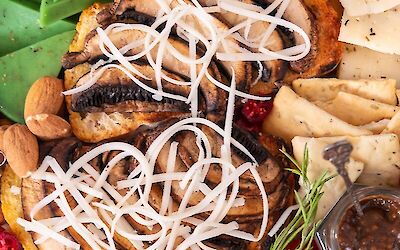Lactose intolerance and goat cheese: how so?
Are you a cheese lover with lactose intolerance? Then there is good news for you! In this blog article, we take a closer look at the relationship between lactose intolerance and goat cheese and discover why it can be an excellent choice.

Goat's cheese: less lactose
First of all, we need to clear up a common misunderstanding: goat cheese is not completely lactose-free. It still contains some amounts of lactose. Although it is considerably less than with cow's cheese. This often makes goat's cheese more digestible for people with lactose intolerance. The fact that goat's cheese contains less lactose than cow's cheese depends on a number of factors:
- Natural breakdown during fermentation: During the cheese booking process, milk is exposed to bacteria and enzymes. These micro-organisms convert lactose into lactic acid, which increases acidity and helps preserve the cheese. This process results in a lower lactose content in the final goat cheese.
- Different milk composition: Goat milk naturally has less lactose than cow's milk. As a result, the resulting goat cheese contains less lactose right from the start.
- Longer ripening time: Old cheese, both from cow's milk and goat's milk, generally has a lower lactose content than young cheese. During ripening, lactose is further broken down by bacteria, so the cheese contains less lactose as it ages.
- Goat's milk contains A2 casein: Some studies suggest that goat's milk contains mainly the A2-type casein, while cow's milk contains both A1 and A2 casein. A1 casein can cause gastrointestinal discomfort in some people, including problems with lactose digestion. Therefore, some people with lactose intolerance may experience fewer symptoms when eating goat milk products.
Aged goat's cheese
If you suffer from lactose intolerance and still want to enjoy cheese, aged goat cheese is probably your best choice. The lengthy ripening process allows old goat cheese to become almost lactose-free. Most of the lactose is broken down, making the cheese easier to digest without your digestive problems.
Goat cheese as a lactose-friendly option
Goat cheese is a delicious option for people with lactose intolerance, especially if you choose aged varieties. Although goat cheese is not completely lactose-free, it contains significantly less lactose than cow's cheese, which usually makes it more digestible. So why deny yourself the pleasure of cheese when you can enjoy the taste of goat cheese without discomfort? Buy cheese easily at Henri Willig, enjoy your favourite cheeses easily and quickly. If you have any questions, feel free to contact our customer service team!
Order via our webshop
Is this article already making you hungry?
Check out Henri Willig's delicious recipes below.
Dutch mature cheese salad
Discover how easy it is to make your own delicious aged cheese salad! This recipe is perfect for brunch, lunch or as an appetiser and puts you on the table within 10 minutes. With a mix of rich old cheese, fresh mayonnaise, soya curd, mustard, honey and dill, you create a tasty salad that will please everyone.
Bruschettas with portobello & truffle cheese
Fancy something special? Then try our bruschetta recipe with a unique twist: portobello and truffle cheese. These bruschettas are not only a healthy choice, but also a true taste explosion for your lunch, brunch or as an appetiser. In just 20 minutes, you can prepare these delicious vegetarian dishes. Follow our simple steps and impress with this tasty creation!





